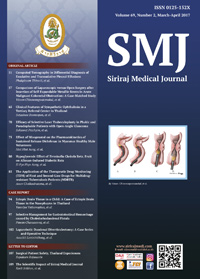The Application of the Therapeutic Drug Monitoring (TDM) of First and Second-Line Drugs for Multidrug-Resistant Tuberculosis Patients (MDRTB)
Keywords:
Pyrazinamide (PZA), cycloserine multidrug resistant tuberculosis, therapeutic drug monitoring (TDM)Abstract
Objective: The study aimed to evaluate the effectiveness, safety, and drug compliance among MDRTB-patients who either undergo therapeutic drug monitoring (TDM) or not to assess the full benefit of TDM related to the disease treatment.
Methods: It was a quasi-experimental design. The study group underwent TDM process to measure serum drug concentrations of pyrazinamide (PZA) and cycloserine (CS), whereas the control group went through the regular process of treatment without taking TDM. All patient information and lab tests were investigated. Descriptive statistics including, frequency, percentage, mean, SD, percentage (s) as well as analytical statistics at confidence interval of 95% (p<0.05) including Fisher’s Exact test were used.
Results: There were no significant differences between measuring and calculating PZA concentrations throughout 4-month periods (p>.05). Overall, the treatment success of MDR-TB among the subjects in both groups were still not satisfied. The common side effects of both medications were reported. Serum concentrations of PZA and cylcoserine were not significantly related to the side effects. Similarly, there was no significant relation between serum concentrations of PZA and drug compliance.
Conclusion: TDM is described as an investigational tool to explore means of improving therapeutic outcomes and reducing toxicity of the current MDRTB medications. Further investigations are still needed.
Downloads
Published
How to Cite
Issue
Section
License
Authors who publish with this journal agree to the following conditions:
Copyright Transfer
In submitting a manuscript, the authors acknowledge that the work will become the copyrighted property of Siriraj Medical Journal upon publication.
License
Articles are licensed under a Creative Commons Attribution-NonCommercial-NoDerivatives 4.0 International License (CC BY-NC-ND 4.0). This license allows for the sharing of the work for non-commercial purposes with proper attribution to the authors and the journal. However, it does not permit modifications or the creation of derivative works.
Sharing and Access
Authors are encouraged to share their article on their personal or institutional websites and through other non-commercial platforms. Doing so can increase readership and citations.











